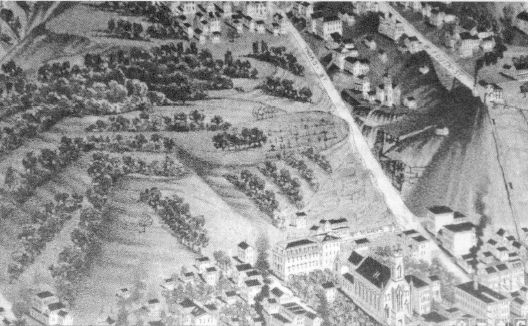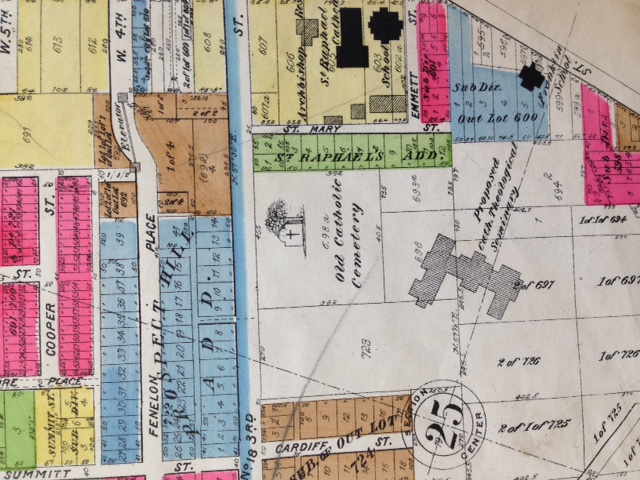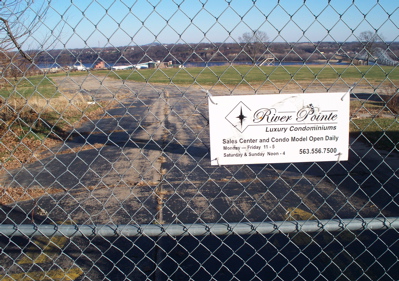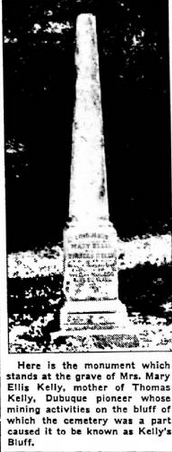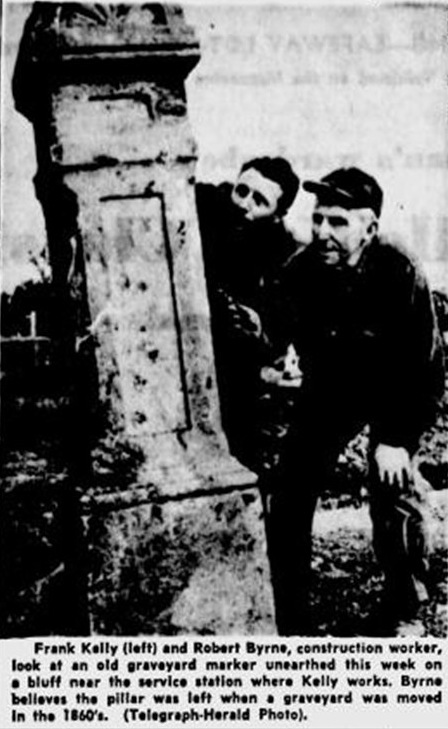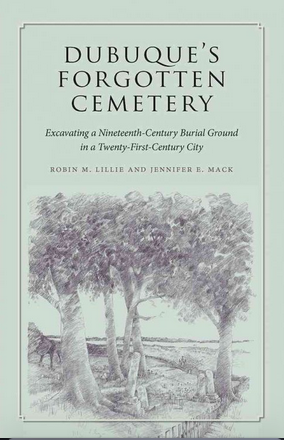Encyclopedia Dubuque
"Encyclopedia Dubuque is the online authority for all things Dubuque, written by the people who know the city best.”
Marshall Cohen—researcher and producer, CNN
Affiliated with the Local History Network of the State Historical Society of Iowa, and the Iowa Museum Association.
THIRD STREET CEMETERY
THIRD STREET CEMETERY. Also known as the “KELLY'S BLUFF Cemetery,” “The Old Catholic Cemetery,” or “St. Raphael’s Cemetery,” the site was located on the bluff between Third Street and Dodge in an area bordered by Cardiff, Third, and St. Mary STREETS. The site had been largely forgotten until July 2007 when the University of Iowa Office of the State Archaeologist Burial Program was contacted by the DUBUQUE POLICE DEPARTMENT. A man walking his dog had discovered human bones. The site was the southern half of a bluff that had once been the location of the St. Dominic Villa, constructed in the late 1940s by the Sinsinawa Dominican sisters. The building had been razed by developer A. J. Spiegel in anticipation of the development of a condominium. The lawn of the old Villa extended into the old cemetery; heavy machinery used in the demolition and grading of the site had scattered the remains. (1)
The cemetery was used by the Catholic community of Dubuque from the 1830s until around 1880. In the spring of 1866 a committee interested in the improvement of the cemetery met to take down the old fence and install a new one. A committee of three was also created to handle the finances of the cemetery. All monies that had been collected and information on accounts to be collected were turned over to them. (2)
The number of people interred in the graveyard was estimated by a contemporary at 3,000-4,000 in 1870. (3) In June 1876 the Third Street Cemetery finance committee of L. Vaughn and H. Fleming had collected $100 in several hours which when added to the $200 already in the treasury indicated that "the long neglected grounds...are now in a far way of receiving that respect and attention worthy of a civilized community." (4)
Reverend Loras Otting, director of archives and historical records for the ARCHDIOCESE OF DUBUQUE noted a typical day’s burial entry: (5)
Burials N. 13, 14, 15, 17.
Note: four persons have been
buried in the graveyard and
no names were given. They
newcomers and they died
by the cholera.
By the time the burial ground fell out of use, 5,000-6,000 may have been interred there. An incomplete funeral register from ST. RAPHAEL'S CATHEDRAL (1839 to 1856) provided the names of almost 700 parishioners who may have been buried at Third Street. (6)
A few entries in the St. Raphael’s register indicate that people had been buried without the families paying for the lots or notifying the clergy. Some of these were recent arrivals in the city and some had died of CHOLERA. These entries, which account for only 28 of the deaths listed in the register, gave rise to exaggerated stories of surreptitious burials and cholera-related mass graves in the bluff-top cemetery. (7)
Though Bishop John HENNESSY officially closed the cemetery in 1867, he re-opened it in 1868, after obtaining legal title to Outlot 723, to the west of the original cemetery lot. The issue of ownership came to the fore when the Bishop disclaimed any obligation to pay his large assessment that resulted from the improvement of West 3rd Street. The City sued the Bishop but lost its claim because the Bishop was right. He did not own it. It was not until around 1906-08 that the ground was finally transferred to the Diocese by the federal government. (8) The western outlot had been used for burials for an unknown number of years and officially became part of the cemetery after the death of the original owner, Thomas KELLY. Though the addition almost doubled the size of the burial ground, the newer section is not shown as part of the cemetery on any city maps.
In 1870, the Third Street Cemetery became the center of controversy when the City Council leased out the mineral rights to the original lot, ignoring the outcry of the Catholic community. (9) Despite these circumstances, the burial ground continued to be used for another decade. The condition of the grounds became a concern. (10)
Ought to be Looked After--The fence around the 3rd Street
Cemetery has been broken down, and cattle roam at large
over the premises defacing the tombstones and destroying
the shrubbery. As a matter of common humanity, this state
of things should be remedied immediately.
In late May 1876 owners of lots and other interested citizens met in the office of J. O'Hea Cantillon to suggest ways in which the cemetery could be protected from vandals. It was decided to repair the damaged fences, improve the grounds, and to build a house on the site in which a sexton could live to supervise the area. Contributions to the plans included fifty dollars from Bishop Hennessy. (11) On October 4, 1876 another meeting was held. H. H. Smyth, the treasurer, reported that the group had cash on hand of $293.50. The amount subscribed but not paid was $124.50. The treasurer reported that this was the entire amount collected to provide a rent free house to a sexton. (12)
In August 1877 the Third Street Cemetery Committee announced that they were preparing a list of those who had and those who had not contributed to the cemetery improvement fund. The writers of the Dubuque Herald commented "a little daylight let into this matter will be healthy and show up facts and figures." (13)
The subtitle of the article "Third Street Cemetery" An Enclosure for Hogs, Cattle and Unruly Boys," indicated the continued dilapidated condition of the cemetery in 1878. The editorial writer added:
Can it be possible that the survivors of the good
people who rest in that cemetery can be unmindful
of the duty they owe their departed relatives, even
if they have no sense of adornment for the benefit
of those who love the beautiful in a grave yard... (14)
In April 1879, the Dubuque Herald noted that in the previous year forty-eight bodies had been moved from the Third Street Cemetery to other sites. One had been taken to the New Mellary cemetery and the others to the Key West cemetery. Eight of these belonged to the Quigley family. (14) As bodies were removed, it was discovered that the land had never been ceded by the United States government. It was remedied when Congress passed an act giving the property to the Catholic Church in Dubuque. (16)
The last documented interment (recorded in the city death records) occurred in 1880. (17)
The cemetery was not officially closed after 1880, and the Archdiocese never issued an order for the removal of the remains. Turn-of-the-century newspaper articles about the new cemetery, MOUNT OLIVET CEMETERY, mention plans to move the graves from Third Street, but there is no record that these removals ever happened. Individual families disinterred their loved ones from the bluff over time, but the majority of the graves remained. By the 1930s, the community believed only a few graves still existed. (18)
In 1939 the Telegraph-Herald reported that there were still about forty markers, tombstones and monuments still standing in the cemetery. (19)
In 1946, the property was sold to the Sinsinawa Dominicans, who built the Saint Dominic Villa to the south of the cemetery lots. Eleven or twelve graves were removed from the Third Street Cemetery at this time, and re-interred in the Third Street section of Mt. Olivet Cemetery. According to eyewitness testimony gathered during depositions for a lawsuit concerning the property, many more graves were destroyed during the creation of a lawn for the Villa around 1948. (20)
In 1959 an old graveyard marker was uncovered that was believed to have come from the cemetery. Hand-carved and made of Farley stone, the stone carried no inscription. The post weighed between 400-500 pounds and was six feet long and fourteen inches on each side. In the late 1960s, the Dominican sisters sold the portions of the cemetery property closest to Third Street. More graves were disturbed during the construction of Kelly’s Bluff Condominiums in the 1970s, and during landscaping on private property in 1994. (21)
The Villa was closed in 1964 after a new convent was constructed at Sinsinawa, Wisconsin. The remaining Villa property was sold in 2002 for $1.5 million to A. J. Spiegel whose River Pointe Development LLC was planning a condominium development on the site. In 2007, after earth-moving activities, exposed human bones were discovered on the property. A team from the Office of the State Archaeologist, University of Iowa, excavated over 900 burials from approximately one-fourth of the cemetery between 2007 and 2011. Poor record keeping and the removal or natural decomposition of wooden markers contributed to the likelihood of newer burials disturbing older interments, leading to stacked burials, or in some cases, the commingling of multiple individuals in one burial shaft, while the cemetery was in active use. (22) Some graves still remained on the bluff. (23)
According to Iowa Burial Law, any body 150-years-old or older is considered ancient and must be treated according to the law. A judge ruled that every potential body found in the former Third Street Cemetery be treated as ancient, so archaeologists studied the remains before turning them over to Pat Leonard, a Dubuque funeral director. (24) Iowa law also dictated that the property owner was liable for the expenses of reburial. A. J. Spiegel paid for all body-recovery costs estimated at $1,000 for each of the 900 found. (25)
6In September 2009, Spiegel sued Sinsinawa Dominican Inc. claiming that they did not reveal that the property they sold to him contained additional graves, his costs of relocating the remains, and the loss of use of the site. (26) The human remains were reburied in the Third Street Cemetery section of Mt. Olivet Cemetery, with the last graveside service taking place in September 2013. (27)
---
Source:
1. Lillie, Robin M. and Mack, Jennifer E., Dubuque's Forgotten Cemetery, Iowa City: University of Iowa Press, 2015, p. 1
2. "Grave Yard Meeting," Dubuque Herald, April 26, 1866, p. 4. Online: https://news.google.com/newspapers?nid=uh8FjILnQOkC&dat=18660426&printsec=frontpage&hl=en
3. Lillie, Robin M. and Mack, Jennifer E. "Bioarchaeology and History of Dubuque's Third Street Cemetery, 13DB476, Dubuque County, Iowa," Office of the State Archaeologist, Research Paper Volume 37, Number 1, 2013.
4. "Caught on the Fly," The Daily Herald, June 10, 1876, p. 4
5. Neva Pederson, Mary. "Who Was Buried in the Third Street Cemetery on Kelly's Bluff," Sept. 15, 2009. IaGenWeb. Online: http://iagenweb.org/boards/dubuque/documents/index.cgi?read=247789
6. "Bioarchaeology and History..."
7. Ibid.
8. Jacobsen, James E. "Phase V Dubuque Historical and Architectural Survey of the Fenelon Place, North Main and Broadway Neighborhoods" June 30, 2005, p. 13
9. Oldt, Franklin T. History of Dubuque County, Iowa. http://www.ebooksread.com/authors-eng/franklin-t-oldt/history-of-dubuque-county-iowa-being-a-general-survey-of-dubuque-county-histor-tdl/page-19-history-of-dubuque-county-iowa-being-a-general-survey-of-dubuque-county-histor-tdl.shtml
10. "Ought to be Looked After," Dubuque Herald, August 20, 1872, p. 4. Online: https://news.google.com/newspapers?nid=uh8FjILnQOkC&dat=18720820&printsec=frontpage&hl=en
11. "Third Street Cemetery," Dubuque Herald, May 27, 1876, p. 4. Online: https://news.google.com/newspapers?nid=uh8FjILnQOkC&dat=18760527&printsec=frontpage&hl=en
12. "Third Street Cemetery Meeting," Dubuque Herald, October 5, 1876, p. 4. Online: https://news.google.com/newspapers?nid=uh8FjILnQOkC&dat=18761005&printsec=frontpage&hl=en
13. "Caught on the Fly," Dubuque Herald, August 26, 1877, p. 4. Online: https://news.google.com/newspapers?nid=uh8FjILnQOkC&dat=18770826&printsec=frontpage&hl=en
14. "Third Street Cemetery," The Daily Herald, September 27, 1878, p. 4
15. "Caught on the Fly," Dubuque Herald, April 6, 1879, p. 4. Online: https://news.google.com/newspapers?nid=uh8FjILnQOkC&dat=18790406&printsec=frontpage&hl=en
16. "Kelly's Bluff, Its Ancient Cemetery, and Foundation of Proposed But Abandoned Seminary; History," The Telegraph-Herald, October 25, 1914, p. 25
17. "Bioarchaeology and History..."
18. Ibid.
19. "Old Cemetery Being Reclaimed," Telegraph-Herald, June 11, 1939, p. 5
20. "Bioarchaeology and History..."
21. Ibid.
22. Humanities and Social Sciences Online : http://h-net.msu.edu/cgi-bin/logbrowse.pl?trx=vx&list=H-Iowa&month=1110&week=b&msg=UKO/FyA3CfhcU2xxaekizQ
23. Ibid.
24. Habegger, Becca. "Human Remains in Dubuque to Be Reburied," KWWL.com, Nov. 16, 2010. Online: http://www.kwwl.com/story/13516416/human-remains-in-dubuque-to-be-re-buried
25. Crumb, Michael J. "Forgotten Iowa Cemetery Stops Condo Plan," Daily Reporter.com, September 22, 2009. Online: http://dailyreporter.com/2009/09/22/forgotten-iowa-cemetery-stops-condo-plan/
26.Ibid.
27."Bioarchaeology and History..."


